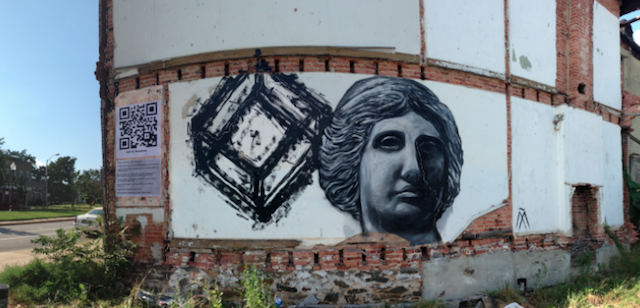
Editor’s note: I tried to write about this fascinating project that just finished up in Baltimore, but for some reason I was unable. So, instead, I asked Nether to write about the project for Vandalog. Nether was one of the co-organizers, so instead of my guesswork and thoughts based on a few articles I had read, now we have a first-hand account of one of the more daring street art projects in recent memory: Wall Hunters’ “Slumlord Project”. – RJ Rushmore
Wall Hunters‘ “Slumlord Project” was a project that installed 17 pieces on dilapidated vacant houses that are owned by people we consider to be negligent property owners. The project was a collaborative venture between the newly-minted street artists’ nonprofit, Wall Hunters, and Slumlord Watch, a local blog that documents the city’s shameful and shockingly large stock of uninhabitable vacant homes. QR codes and text descriptions were pasted alongside the art. A cell phone app scan of these instantly unveiled ownership information on the guilty landowner by linking to the Baltimore Slumlord Watch website. The artists’ ephemeral work and the community reaction to it was recorded for a documentary being produced by the project’s third partners, filmmakers Tarek Turkey and Julia Pitch. The project’s goal was to catalyze a larger conversation on Baltimore’s vacancy issue–a conversation that includes the normally muted voices of those who live in the targeted neighborhoods, as well as politicians and the developers whose phone calls get answered by city hall.
The idea for the project was born about a year ago. At that time I was putting up wheatpastes on dilapidated, vacant houses. As I was researching specific properties I was hitting, I regularly came across the Baltimore Slumlord Watch blog run by the housing activist Carol Ott. Slumlord Watch is basically Wiki-leaks for Baltimore’s underfunded housing authority. As blog posts make clear, many of the blighted houses are owned by entities with the means to fix their crumbling properties–slumlords who blithely ignore the cost of their neglect on city communities. Since much of my work uses images to deal with the vacancy problem and Carol was battling the same issue, we decided to meet and try to do something that joined street art with housing activism. I began driving her around while she catalogued vacants and researched ownership, and I wheatpasted.
Originally, the idea for the project was quite hypothetical and, we thought, unrealistic due to its necessary unsanctioned nature. It all started coming together when we met with a foundation that ultimately offered us funding for the majority of the project. As we thought through a grant proposal, our idea began to take form and seem plausible. While I was in europe last fall, I drafted the proposal and after I returned, Tefcon and I founded Wall Hunters from which we launched the project.
From fall to early July, Carol and I did a ton of ground research trying to explore locations for installations as well as meet neighbors, learn from them about the impact of vacants in their neighborhood, and get them on board with our efforts. The filmmakers often came along, chronicling our conversations.
One beautiful aspect of Baltimore is that it is a city defined by its unofficial culture whether it be 12 O’clock dirt bikers racing through city streets, snowballs sold off porches, neighbors escaping stifling rooms by sitting on their front steps “stooping”, or horse-drawn “arabber” produce hawkers, street culture’s honesty shows the contrivance of official culture concocted by marketers wishing to attract tourist dollars. Generally in the world of mural work there is a focus on getting permission and permits from the powers that be rather than the endorsement of the audience who will live next to a mural. While soliciting official sanction may often be necessary, the most rewarding part of bringing art to neighborhoods for me is getting community support behind the installations. During our research we met many residents and it is they who were really responsible for bringing our project to fruition. Residents got it how the art was a form of civil disobedience necessitated by the City’s decades-long failure to grapple with their neighborhoods’ demise. Residents and even neighborhood associations welcomed the attention, shared the stories of their communities’ battles for city resources and bolstered our determination to act. The people who gathered and talked to the artists and filmmakers as we worked were clearly at the end of their ropes and infuriated at the ways their communities are ignored. They were insulted that City money is allocated for building new, posh districts aimed at attracting new, richer residents and tourists rather than rebuilding existing lower and middle class neighborhoods. Our art was not only welcomed, it energized residents because somebody was finally listening to their concerns. The film will be a crucial way to amplify the voices of those residents.
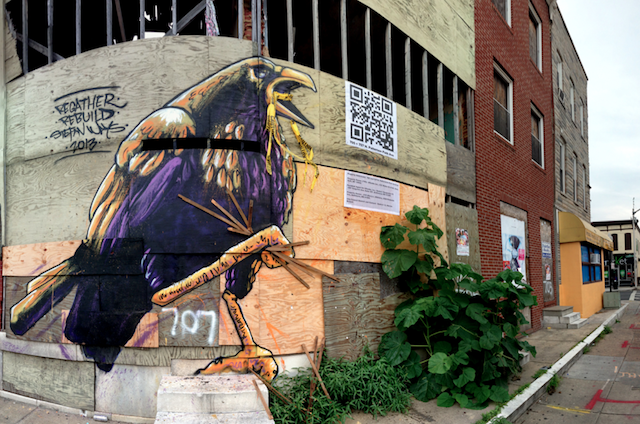
The piece that kicked off the project was done by Stefan Ways at 707 and 709 Patterson Park Avenue. The truth is that I’ve always been a little skeptical that art realistically could be an effective tool for social change. Would installing pieces on vacants actually get them dealt with? Ways’ install showed art has that power, especially when art and daring attract media attention. Ways’ canvas was a property left so decrepit for so long that rebuilding would be impossible. Within weeks after installing the piece, the city slapped a notice on the building announcing stepped up plans to demolish it. Coincidence? (Baltimore Brew wrote a great article about the demolition that is worth reading) Our platform is not a demolition platform, but this property and many others pose such dangers to the structural integrity of adjacent properties and the community that demolition is the only real remedy.
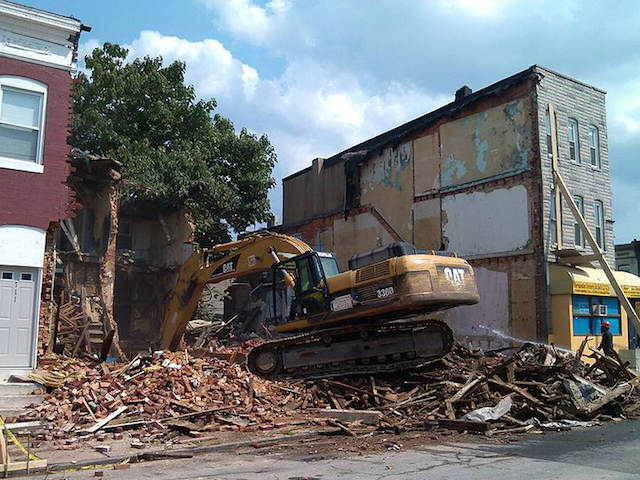
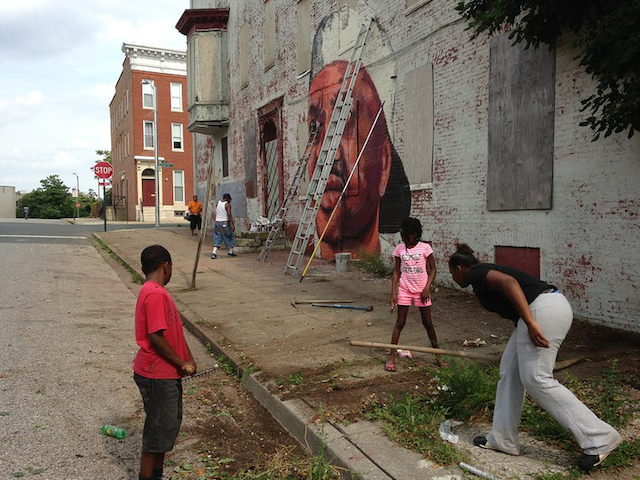
Second up: Nanook’s piece at 918 N. Arlington Street
Doing this install was a poignant experience. We began the piece a day after a quadruple shooting two blocks away from the spot on Carlton Street. When we arrived, we saw weeds climbing the lead-paint encrusted wall blocking where the mural was to be. A man who lived on the block chatted with us as we assessed the situation. Then he went back to his house and a few minutes later returned, rounding the corner with an armful of all the tools necessary to clean up the block. Soon, four kids showed up to help him pull up weeds in the heat for hours and hours. I’m not sure what catalyzed this to happen, whether it was the desire of the community to do something positive after a lot of ugliness that had occurred in the neighborhood but, regardless, the install turned into something incredibly positive for the block.
Last: Installs by GAIA and LNY and shit hitting the fan with Stanley Rochkind
Both GAIA’s and LNY’s pieces are on properties owned by Baltimore’s infamous slumlord, Stanley Rochkind. Carol has for years poked at Rochkind through Baltimore Slumlord Watch trying to get him to clean up the problems he has created and ignored. Through his related businesses he owns about 15,000 properties in the city and gained special infamy for failing to deal with 500 lead paint houses among his inventory. He is the type of sleaze who complains that the City should go after the ancient paint manufactures rather than fine him.
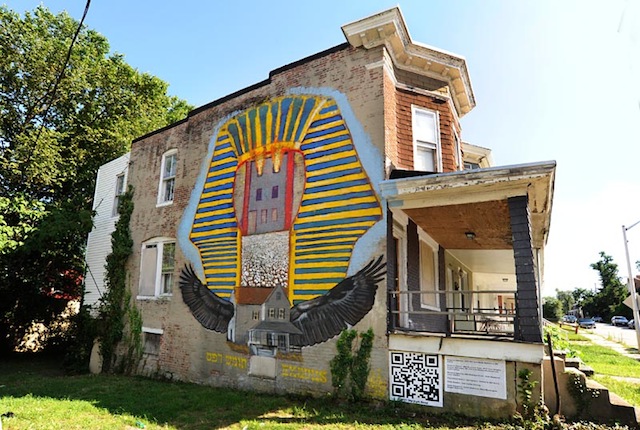
Weeks after GAIA’s install, the Baltimore’s daily newspaper, The Sun, jumping on a wave of publicity both local and national, came out with an article in which it made a transparent attempt to gin up readership for a dying Murdock rag by suggesting that our property research was sloppy and we’d targeted an innocent businessman. It wasn’t and we didn’t, but the paper didn’t bother to check the facts when Rockind denied culpability and claimed he no longer owned the targeted building. Not satisfied with it’s own half-assed work, The Sun also gratuitously revealed my legal name as well as GAIA’s. After GAIA painted his mural, Rochkind contacted the Baltimore Police Department calling the mural, whose message played on the common experience of African Americans in the Great Migration and Jews in the exodus– an anti-semetic hate crime. City Paper came to our defense: “What this is, really, is a blatant attempt by Rochkind and his agents to blow smoke up The Sun’s ass and it worked.” It seems in the end Rochkind’s attempt to distract the media from the fact that he is one of Baltimore’s worst slumlords backfired and got his name a lot more attention than he wanted.
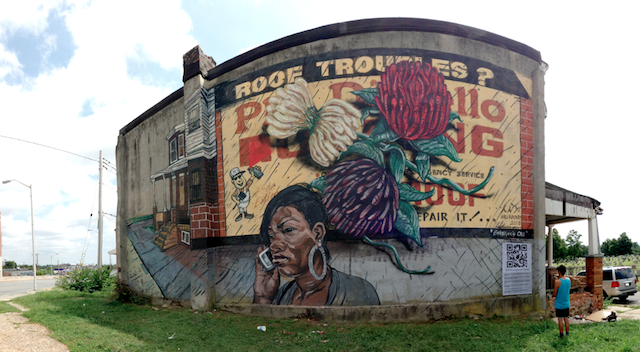
One thing I have learned about throwing stones at a beast is that you’ve got to keep on throwing and never back down. The morning the Sun article came out, LNY began painting his piece at 539 N. Longwood Street, another Rochkind owned property. We’d handed out tons of flyers asking residents to report to us properties that have negatively affected their families. After seeing a story the local ABC new station did on the project, a lady named Shawnee contacted us saying that she had been fighting SS3 Business Trust and the City for years trying to get the property next to her’s dealt with. As soon as she contacted me, I sent the address to Carol who pulled the information and, whad’ya know, it turned out that SS3 is a Rochkind company. Carol and I visited the property and talked to Shawnee about the problems it had been causing her. The property had just about everything imaginable wrong with it from leaking water (flowing, really) to a collapsed roof, from rodents to a nasty termite infestation that was making its way through the support beams into Shawnee’s home. She’d made countless calls to the City and to SS3. Nobody was listening to her concerns even after thousands and thousands of dollars in damage to her property. She had hit a wall. To us, this appeared to be the perfect illustration of the type of landlord that Rochkind really is. Shawnee introduced us to many of her neighbors who have been dealing with the same types of absentee landlords. I visited the neighborhood association president’s home with the reporter Baynard Woods to hear about the vacancy problem in the neighborhood, talk about other walls to paint, and try to brainstorm how we could draw attention to the area through our efforts, including by mobilizing residents to file complaints about properties. LNY’s amazing wall memorializing Shawnee’s calls us illustrates how out-of-the-box projects like this one have the power to steer uncharted waters and bridge gaps that seem unspannable. Next time I talk to Shawnee, I am going to ask her if she will be on our board.
Here are the rest of the installs:
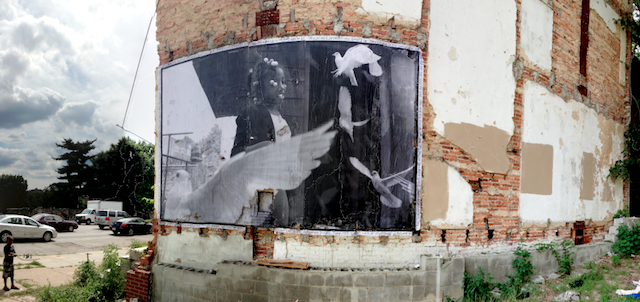
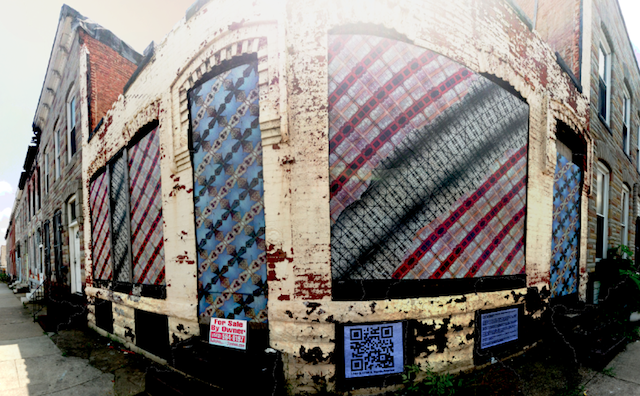
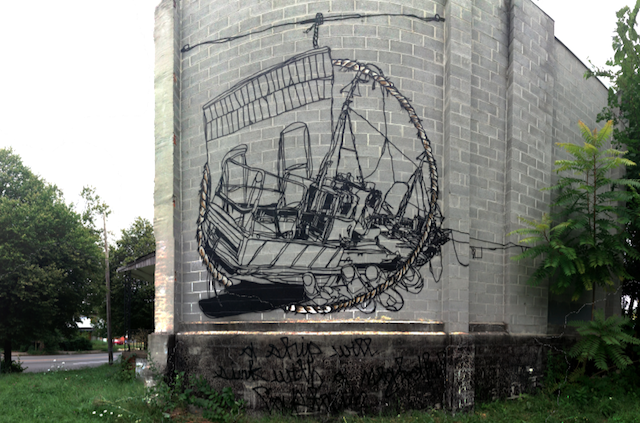
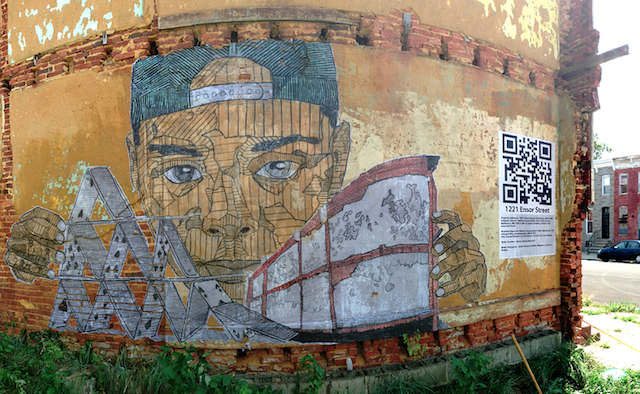


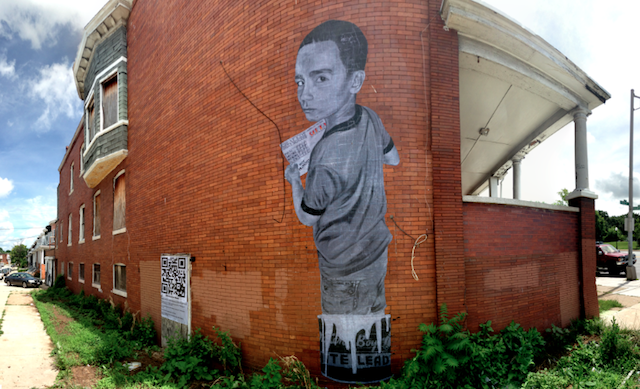
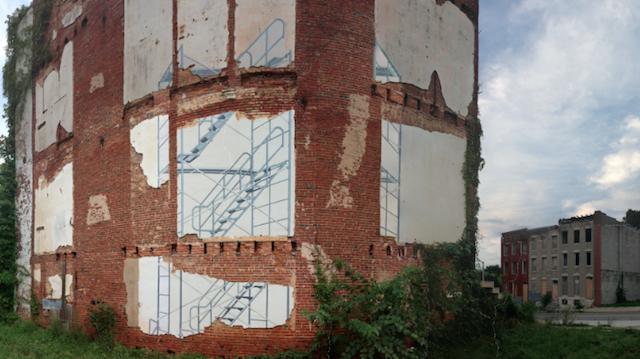
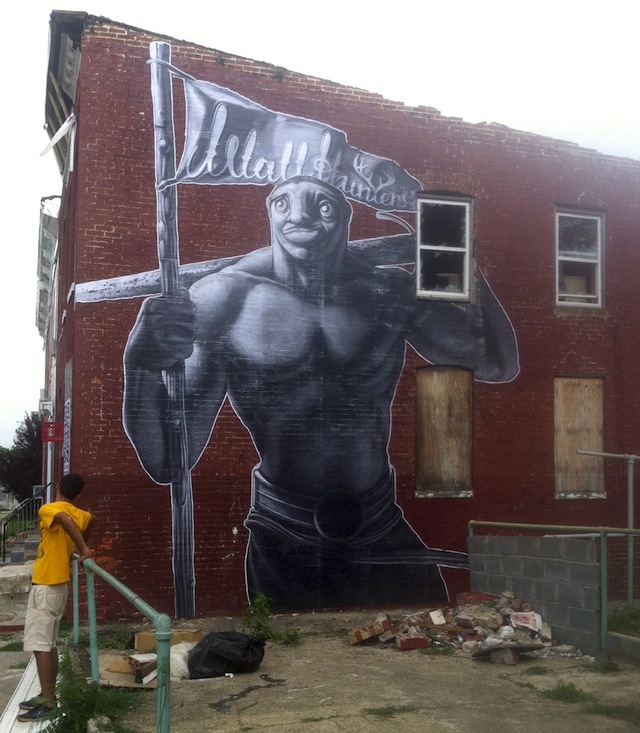
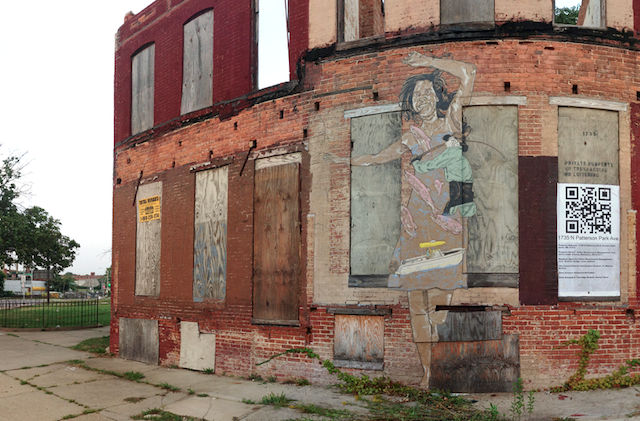
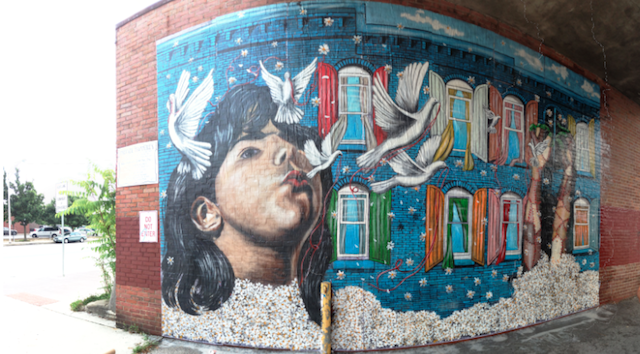
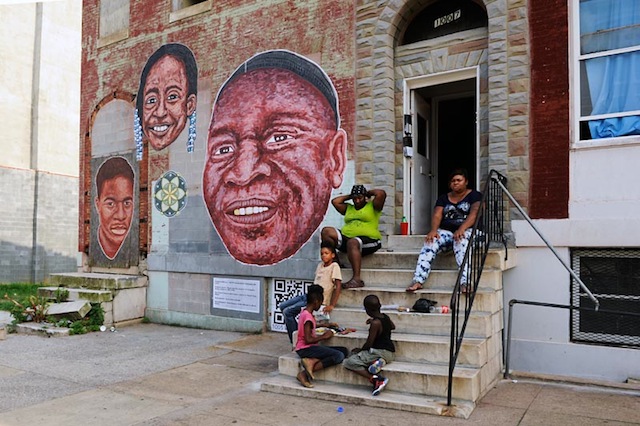
Photos courtesy of Wall Hunters and by Martha Cooper
